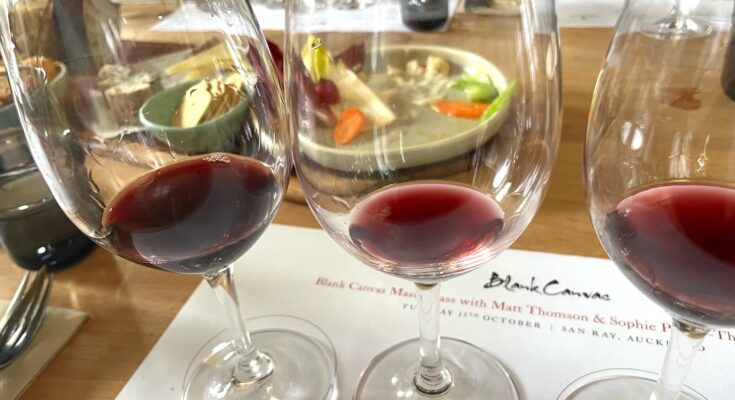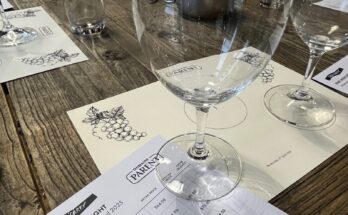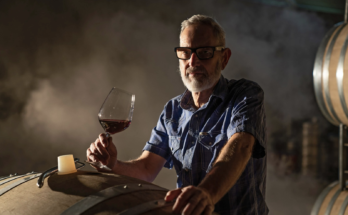Working together, a Master of Wine – Sophie Parker-Thomson, and Master of Science – Matt Thomson, make wines under the Blank Canvas brand. Organised by Eurovintage, and hosted in the beautiful room upstairs at San Ray in Ponsonby, this was a chance to not only run through their current range and vintages, but to gain some valuable insights into their home turf of Marlborough as well.
They talk a lot about Appellation Marlborough Wine – Sophie is Chair of the commitee – the project now contains over 50 members, large and small. Criteria has recently been tightened for labels to meet membership rules. Matt tells the room that 50% of all New Zealand wine is now bottled overseas – so when you consider that fact alone, it is no wonder that such an initiative has blossomed. Blank Canvas bottles all have the AMW wine mark on them.
Not all the Blank Canvas wines come from Marlborough fruit – they’ve made a couple of Pinot Noirs from Central Otago, and a Syrah from Hawke’s Bay. Their ethos is to take top quality parcels of fruit from the very best sites… as and when they are available. They don’t own any vineyards of their own, although with Matt having done over thirty harvests, the relationship with many growers runs deep.
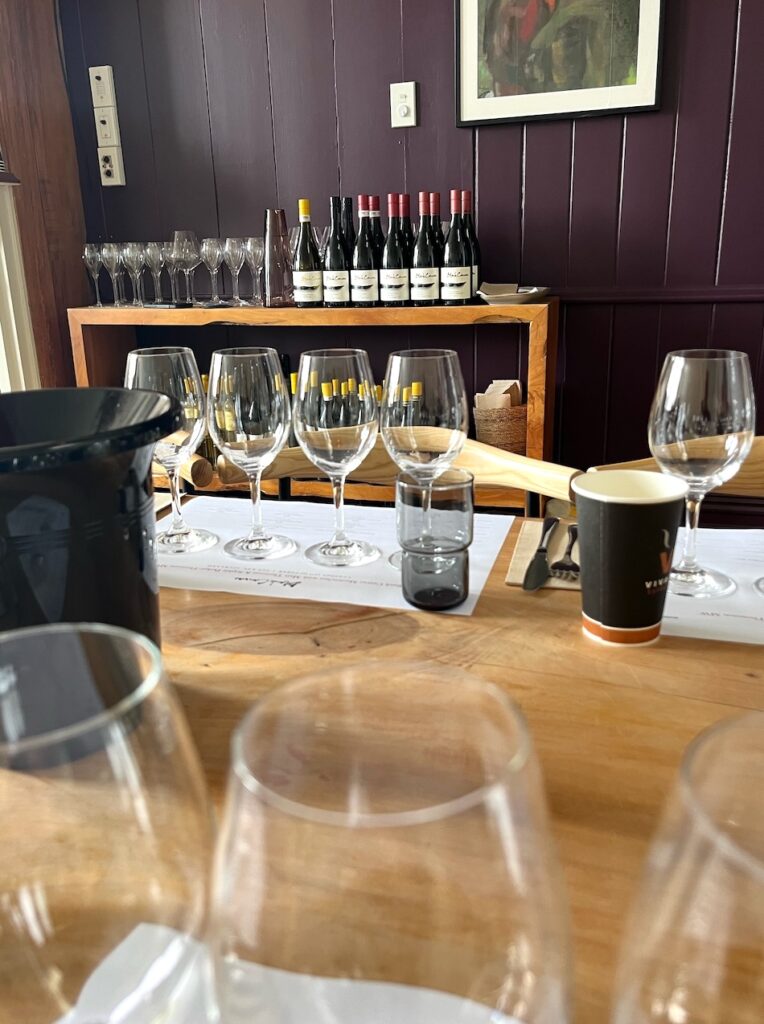
We start with a look at the Anandale Farm Riesling 2024. It is described as ‘the cleanest fruit we’ve ever seen’. Some quite low overnight temperatures (3-degree nights in February!), very dry conditions and decent winds meant very low disease pressure – keeping the fruit in great shape. A beautifully aromatic wine – like something (decent) from the Saar Valley, with low alcohol and some pure fruit ripeness that is so balanced by the crystalline, cool acidity that you really don’t notice a sweetness. Clean, with no bite of phenolics, and just a slight slipperiness through the mid-palate. It has a spark of energy that runs into the dry, intense finish.
They make a pair of contrasting Sauvignon Blancs. Holdaway Vineyard Sauvignon Blanc 2024 takes fruit from the eastern Wairau Valley, in the coastal sub-region of Dillons Point. Having those classic Marlborough notes of passionfruit and blackcurrant, there is also a very saline acidity that heightens the vibrancy into a real tang and brightness. Slatey minerality makes it look quite Chablis-like and would lean it towards being a great match for a plate of oysters. Very dry, salty and seedy. It does have richness and weight through the palate too, and a long, pithy finish.
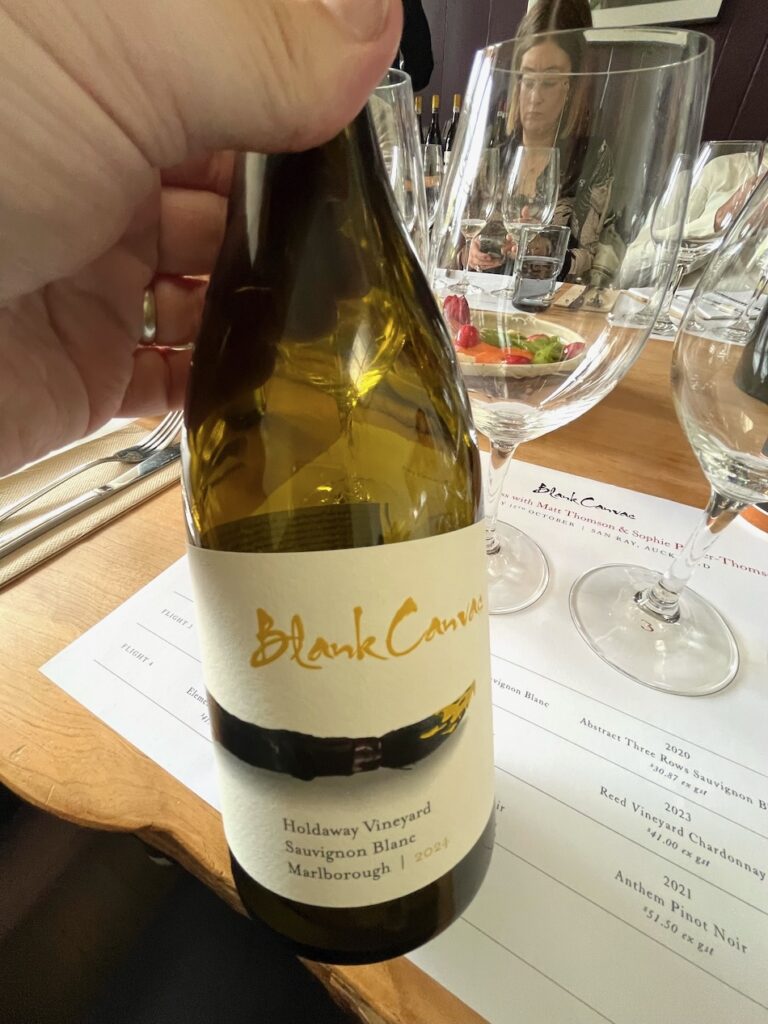
Abstract 3 Rows Sauvignon Blanc 2020 also hails from the Holdaway Vineyard, but is a different beast altogether. Less about fruit, and looking more at fine white Bordeaux styles. There is still a salty note on the finish, and notes of blackcurrant abound; but the palate here shows a musky incense character and a little pepperiness. Almond, elderflower, lemon peel and grapefruit flavours slide around, whispering from the corners. As you go, there’s a textural depth and roundness to the mouthfeel, and the finish is bone dry. Should age extremely well.
One of the brand’s more distinctive wines is the Grüner Veltliner 2023. Until recently, current vintage was the 2017, so you know it isn’t a wine that has to be drunk in the year it was made – but the 2023 is just as good. Interesting, when I tried the Blank Canvas version of this wine it was the first New Zealand Grüner that I hadn’t spat out! hahaha. See my conversation with the Blank Canvas duo here for more on that > www.winefolio.co.nz/?p=4249. It’s a grape that isn’t widely planted here (less than 40 hectares) and this one is from the Southern valleys of Marlborough. The signature white pepper is there, and although quite spicy it is well-balanced, with golden, tropical flavours and then some greener notes of wheat grass and pear. A gentle waxy texture adds complexity and the finish is a mile-long.
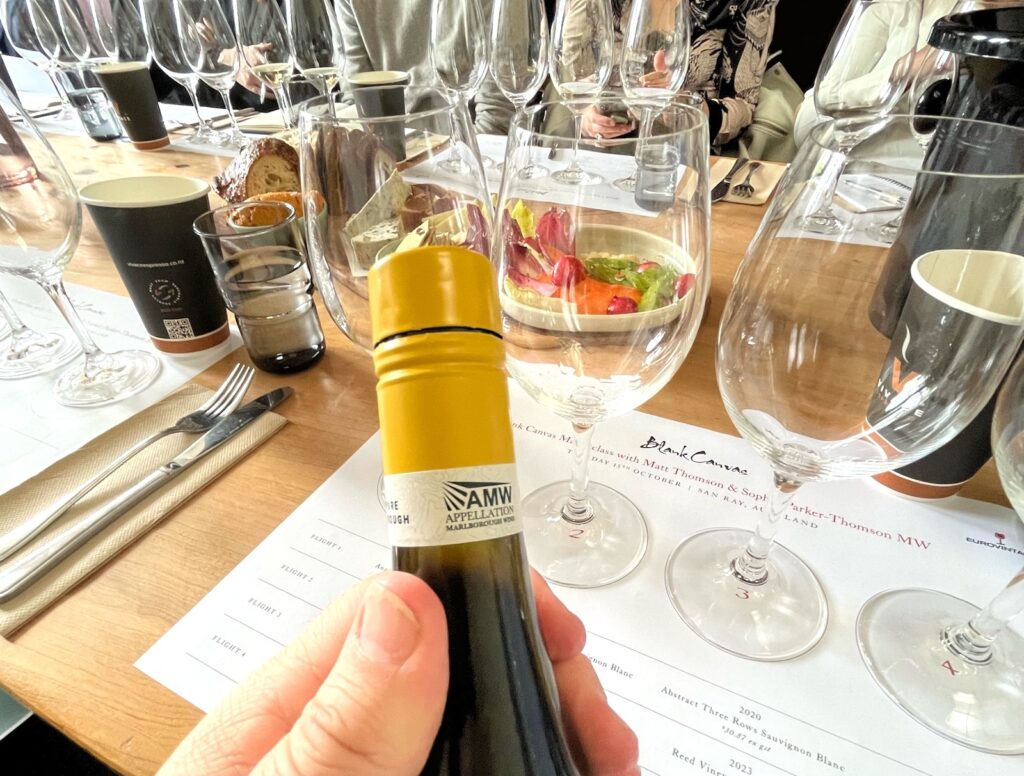
A new wine is always an exciting addition to a tasting. ‘Tano’ Chardonnay 2023 has the black label (like the Abstract). Made in a 3,500 litre barrel, it is quite the contrast to the Reed Chardonnay that has done so well for them. Quite soft on the nose, with chestnut, apple, lime and grapefruit. With a good swirl, there is some vanilla and baking spice too. In fact, this particular wine evolved quite rapidly in the glass. I wasn’t the only attendee to note it. Bone dry, elegant and in a classic, very tight style. I hate to mention Chablis again – but at least this one IS a Chardonnay! I’m not 100% sure what to make of it. It is delicious, has real finesse, and is undoubtedly a smart wine, but it didn’t really tick my boxes. As the pair mentioned on the day – you want to make a wine that someone loves, rather than what people “think is OK”. I liked it, didn’t adore it.
The Reed Chardonnay 2023 is the latest vintage of a wine that I know from around many, many tables, and I can report that it definitely has some admirers. That smoky flint is a signature scent. Savoury and toasty, the 40% new oak makes its mark, framing the golden fruit. Dried pineapple, quince, peach, apple and lemon blossom. A really powerful expression, with weight and zesty acidity to offset and add drive and length through the palate. Complex, with great concentration and coltish energy. As good as it always is. In fact, maybe a little more weight and carry – the finish is very long.
After that we re-set to reds. The pair of Marlborough Pinots are newer vintages for me. Settlement Vineyard Pinot Noir 2020 is from a vineyard that a few people are taking fruit from. The Blank Canvas rows of Clone 777, are at the back of the vineyard, getting afternoon sun. Lots of spice and florals take over the perfume, hinting at a large percentage of whole bunch in the ferment. A pale colour – a translucent garnet. But it really is spicy, and there is a dry, dustiness to the tannin. It is quite varietal, in a savoury way – not reliant on juicy New Zealand style to carry the palate. There is fruit, of course, but the effect is lean and muscular.
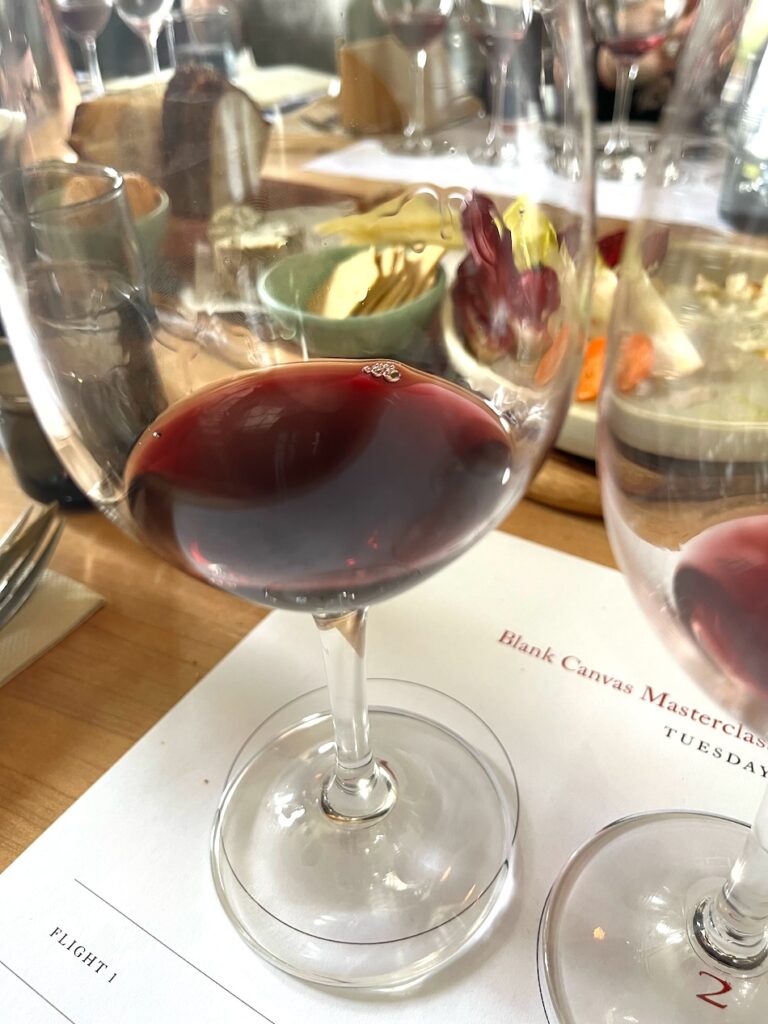
Also lighter in colour, although heading more into a deeper, traditional ruby tone – The Escaroth Pinot Noir 2021 has a bountiful scent that contains a little funk, plush red fruits and plenty of spice. This one comes from Taylors Pass in Marlborough. It manages to be cool and pristine with a pop of crunchy fruits, and on the other hand quite brooding, toasty and rounded. Complex. It is a super Pinot. Silky texture and with floral notes carrying right through the palate. A long, sweetening finish.
Good fruit means not just Marlborough of course – and Matt and Sophie have an affection for Gibbston in Central Otago as a source. The Anthem Pinot Noir 2021 is from the well-known, and relatively old (for Central) vineyard of the same name. Scented with classic Central Otago notes of thyme, lavender, rosehip and rose petal alongside the dark red fruits – a wine of finesse and delicacy. Again, I get a certain sense of whole-bunch in the winemaking, with a relative lightness of colour, and robust spice characters. Deeper in there’s some nettle and negroni ‘good bitterness’ which just adds complexity.
Staying in Central, but moving down the road to Bannockburn, the Una Volta Pinot Noir 2020 source is the Renaissance Vineyard – next to the Calvert Vineyard – on Felton Road. Cherry, raspberry and plum are lifted by a dried herb and pot pourri on the nose. Tannin plays more of a part here – fine, sinewy and with a little grip. Black tea, loam and white pepper add savoury elements to a well-structured palate. Dry from start to finish – perhaps a reflection of site – there is a super length to the finish.
The last wine showcases one of New Zealand’s real gems – Hawke’s Bay Syrah. Earlier in the day I’d given a presentation to a room full of retailers about New Zealand’s strengths, and the question of this varietal from this region had naturally come up then. Element Syrah 2019 is from the important Gimblett Gravels sub-region and showcases our cool-climate style of this grape – in a great vintage. The bouquet shows damson, blueberry and cassis, with black pepper, tar, cacao nib, violets and iron earth notes. Well-structured, with an interplay of chalky tannin, frisky acidity and some savoury spice (whole bunch again?) to offset the lush juice. A sense of green also emerges over time in the glass – sap, mint and balsam. A lot going on – a terrific wine that would cellar extremely well.

